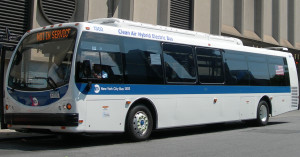
New York city has the nation’s biggest fleet of hybrid buses, which run on electricity and diesel fuel, with more than 1,000 in all five boroughs, most in Manhattan.
Although the initial cost is well above that of a conventional diesel-powered bus, hybrid buses emit less pollution and get far better fuel economy. They are quieter than old-style buses, and their ride is generally more comfortable (not accounting for the condition of city streets). Like the hybrid taxis that have become a common sight in New York, hybrid buses arrived during the last decade.
In 1998, the transit authority began using its first 10 hybrid-electric buses, costing $1 million each; they became guinea pigs for what turned out to be a successful experiment. By 2001, the city had ordered another 125 and subsequently bought hundreds more. Today, New York has the largest fleet of hybrid buses of any city in the country although hybrid buses are still twice as expensive as conventional diesel buses.
Environmentalists argue that the switch has been worth it, in terms of public health. From 1995 to 2006, diesel particulate emissions — also known as soot — dropped 97 percent, while emissions of nitrogen oxides dropped 58 percent per bus.
The buses’ performance has been impressive, especially by bus standards. Each is expected to save the city 50,000 gallons of diesel fuel, compared with what would be consumed by a conventional bus, or a 45 percent improvement in fuel economy.
Much of the fuel economy savings can be traced to new lithium-ion batteries, like those on a camera or cellphone, which have been installed in the buses. Their early batteries, which were lead acid, cost $20,000 and needed to be replaced every two to four years. The lithium batteries are expected to last six years, and the weight difference alone equals a 13 percent improvement in fuel economy. But those batteries are expensive, at $60,000 each.
The batteries mean that overall maintenance for New York’s hybrid buses is more costly than for conventional diesel buses. However, the hybrid buses are easier to fix — and most important, don’t break down as often, which the department measures as “mean distance to failure.”
The newest buses to make their appearance in the city are a pair of turbine-driven hybrids, the first of eight that will join the fleet. Moreover, the bus will not need a filter to catch particulates, small bits of filth from diesel fuel. The filter normally requires changing every year.
If New York’s experience with hybrid buses is any indication, other communities could follow the city on its path to cleaner transportation.